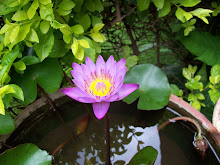 Many plants were considered sacred by the ancient civilizations. The Datura was a sacred plant of the Aztecs. It has always been used in shamanic rites, and as a hallucinogen. Recent research shows that the Maya considered the Silk Cotton tree, Ceiba pentandra a sacred tree representing the Universe.
Many plants were considered sacred by the ancient civilizations. The Datura was a sacred plant of the Aztecs. It has always been used in shamanic rites, and as a hallucinogen. Recent research shows that the Maya considered the Silk Cotton tree, Ceiba pentandra a sacred tree representing the Universe. The Hindus consider the Sweet Basil, Ocimum sanctum sacred. They have a festival in autumn in honour of the plant, which they consider to be the representative of Lakshmi, the goddess of wealth and beauty and the Universe.
The Hindus consider the Sweet Basil, Ocimum sanctum sacred. They have a festival in autumn in honour of the plant, which they consider to be the representative of Lakshmi, the goddess of wealth and beauty and the Universe. For the Buddhists, the Bodhi Tree is most sacred because Buddha attained Enlightenment under the tree. The Bodhi Tree is thought to represent the Universe.
For the Buddhists, the Bodhi Tree is most sacred because Buddha attained Enlightenment under the tree. The Bodhi Tree is thought to represent the Universe.All these plants have special healing powers.










